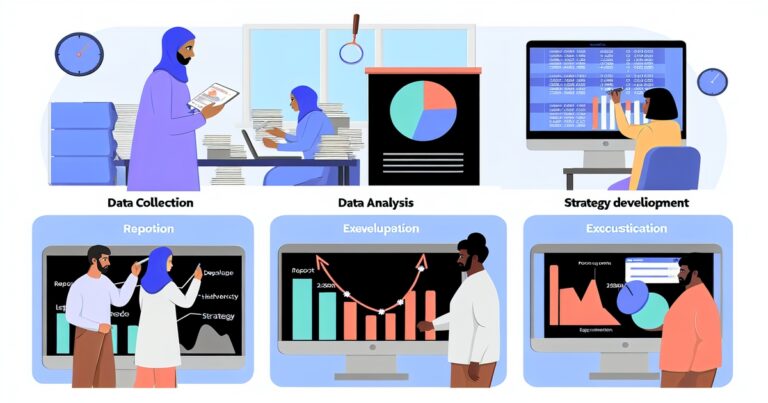Did you know that businesses make an average of $2 in revenue for every $1 they spend on Google Ads? That’s right, diving into the world of Google Ads campaigns can be your golden ticket to skyrocketing sales and visibility. But here’s the kicker: setting them up can feel like navigating a maze blindfolded if you’re not clued up. No sweat though, because we’ve got your back. Whether you’re a total newbie or looking to polish your skills, this post will walk you through the essentials of setting up successful Google Ads campaigns, focusing on search terms and links, without breaking a sweat or spending too much money. Let’s demystify the process and get those ads working for you!
Key Takeaways
- Setting up a Google Ads campaign requires a clear understanding of the platform, starting with the basics and moving towards more advanced features to fully leverage its capabilities.
- Before creating your campaign, planning is crucial. Identify your goals, target audience, and budget to ensure your campaign is structured effectively.
- The campaign creation process is iterative, involving setting up an account, choosing the right settings, and crafting compelling ad content that resonates with your audience.
- Optimization doesn’t end once the campaign is live. Regularly reviewing performance, adjusting settings, and refining ad content are key to maximizing results.
- Utilize advanced Google Ads features, such as audience targeting and ad extensions, to enhance your campaign’s reach and effectiveness.
- Managing your Google Ads campaign effectively involves a balance of strategic planning, ongoing optimization, and leveraging advanced features to stay ahead of the competition.
Understanding Google Ads
Google Ads Functions
Google Ads is a powerful tool for businesses. It helps you reach specific audiences quickly. Targeted advertising lets you show your ads to people with certain interests or who are in search of products like yours, enhancing your campaign’s click-through rates on Google links.
With Google Ads, tracking how well your ads perform based on clicks, campaign success, and search term relevance is a straightforward way. You can see how many people clicked on your ad and what actions they took on your website. This makes it easy to measure success and make necessary adjustments.
Managing costs is another key function of Google Ads. You have control over how much you spend daily on your Google Ads campaign, ensuring that advertising with discovery ads doesn’t exceed your budget options.
Types of Ads
There are several types of ads and options that you can use in Google Ads campaigns to target people by search term.
- Search ads appear right when someone searches on Google for something related to what you offer.
- Display ads are visual banners shown across various websites within the Google Display Network.
- Video ads play before or during YouTube videos.
Each type of Google Ads campaign serves different purposes and targets people at various stages of their buying journey, using various ad groups and options. For instance, search ads capture users actively seeking what you’re offering, while display and video ads work well for building brand awareness among those who might not be searching yet.
Cost Considerations
Understanding the cost structure in Google Ads, including campaign options and search term factors, is crucial for effective budget management.
The most common pricing model in Google Ads campaigns is pay-per-click (PPC), meaning you only pay when someone clicks on your ad. This model, one of several options, allows for efficient use of advertising budgets since it focuses spending on potential customers showing interest in your product or service.
Setting a daily budget controls overall spending by capping the amount spent each day on Google ad group campaigns. This ensures that costs don’t unexpectedly skyrocket.
Competitive keywords often come with higher costs due to more advertisers bidding on them. Choosing the right keywords for your Google Ads campaign requires balancing between relevance and competitiveness within an ad group to maximize return on investment.
Setting Up Google Ads Account
Account Creation
Creating a Google Ads campaign starts with having a Google account. If you don’t have one, it’s easy to create. Go to the Google Ads website and click on “Start now.” You’ll need to provide some basic information about yourself or your business.
The process doesn’t stop there. After signing up, you’ll go through a verification process. This step is crucial for activating your account. It ensures that only legitimate users are setting up ad campaigns on the Google platform.
Business Information
Next, adding your business information is key. This includes your business name, address, and phone number (often referred to as NAP). Why does this matter? Well, it helps in personalizing your ads. More importantly, it boosts your local SEO ranking.
Imagine someone searching for services you offer in their area. If your business info is accurate and consistent across the web, including in your Google Ads campaign settings, chances are higher they’ll find you.
Payment Details
Lastly comes setting up payment details. For most businesses starting out with a Google Ads campaign and digital advertising, using a credit or debit card for billing makes sense.
You also have the option to link a bank account directly if that’s more convenient for you.
Here’s where things get interesting – choosing between automatic and manual payment settings for your Google Ads campaign
- Automatic payments mean Google charges after accruing ad clicks over time.
- Manual payments allow more control since you preload funds into your account before ads run.
Choosing a Google ad campaign depends on how closely you want to monitor spending versus convenience.
Planning Your Campaign
Advertising Objectives
After setting up your Google Ads account, the next step is planning your campaign. This begins with defining clear advertising objectives. What do you want to achieve? You might aim to increase website visits, boost engagement or conversions, or enhance brand awareness through Google ads.
Each objective requires a different approach. For example, increasing website visits may involve targeting broader keywords. In contrast, boosting engagement with Google ads could mean focusing on specific demographics. Enhancing brand awareness often involves display and video ads that reach a wide audience.
Selecting Campaign Goals
Choosing the right campaign goals is crucial. They must align with your business objectives. Google Ads offers several options like sales, leads, and website traffic.
Your selection influences many aspects of your campaign setup. It affects ad formats available to you and where your ads can appear. If sales are your goal, you’ll likely focus on Google ad conversion-optimized campaigns. For leads generation, forms and call-to-action buttons become essential tools. Website traffic goals push for maximizing clicks and impressions.
Budgeting Strategies
Budgeting wisely is key for successful campaigns. Start small to test the effectiveness of different strategies. Then adjust based on performance data. This flexible approach allows you to optimize Google ad spending without wasting resources.
Consider industry benchmarks and Google Ad performance when setting budgets but remember these are just guidelines. Your specific costs will vary depending on competition in your sector and target keywords’ popularity.
- Pros of starting small:
- Minimizes risk
- Allows for testing different approaches
- Cons:
- May limit initial reach
Adjustments should be made regularly as you gather more data about what works best for achieving your goals.
Campaign Creation Process
Choosing Campaign Type
Expert Mode
Expert Mode in Google Ads offers advanced features for those who want more control. It lets you customize your bidding strategies. This means you can decide how much you’re willing to pay for clicks, impressions, or conversions on your Google ad.
You also get detailed targeting options. You can choose who sees your Google ads based on their interests, habits, and where they’ve been online.
But remember, with great power comes great responsibility. Using Expert Mode requires a good understanding of Google Ads.
Simple Steps
For beginners or those looking for simplicity, following simple steps is key.
- Choose the campaign type that fits your goal.
- Set up ad groups and select relevant keywords.
- Craft compelling ad copy that speaks to your audience.
This approach keeps things straightforward but effective.
Selecting Goals and Budgets
Setting goals should align with your Google ad marketing strategy discussed in planning your campaign section.
Your goals might be driving sales, generating leads, or increasing website visits. Each goal needs a different approach in Google Ads.
Budget setting is crucial too. Here’s what matters:
- Your budget should reflect both your goals and what market research shows.
- Be realistic about what you can spend daily on ads.
- Use Google’s recommendations as a starting point but adjust based on what works for you.
Remember to review performance regularly and adjust budgets accordingly.
Optimizing Campaign Settings
Location and Language
Once you’ve created your Google Ads campaign, the next step is to optimize it. A crucial part of this process involves setting up your ad campaign’s location and language. This means targeting ads to specific locations or regions where your audience is based. It can be as broad as a country or as narrow as a city block.
Choosing the right languages, including ad languages, that your target audience speaks is also essential. If you’re running a global campaign, consider including multiple languages to widen your reach.
To fine-tune who sees your ads, adjust these settings for broader or narrower reach depending on your goals. For instance, if you’re targeting tourists in France but only speak English, set the ad location to France and language to English.
Bid Strategy and Keywords
Another critical aspect of optimizing ad campaign settings lies in deciding between automated and manual bidding strategies. Automated bidding lets Google adjust bids for you with the goal of getting more conversions or clicks within your budget. Manual bidding gives you control over how much you pay for each click.
Researching and selecting relevant keywords carefully cannot be overstressed. They are what connect user queries to your ads.
- Use tools like Google Keyword Planner for insights.
- Include both broad match keywords for wider visibility and exact match keywords for more targeted traffic.
Don’t forget about negative keywords either; they help exclude unwanted traffic by preventing ads from showing on searches that include those words.
Device Targeting
In today’s digital age, understanding device usage patterns of your target audience can greatly impact ad performance. Optimize ads specifically for mobile devices if analytics show high mobile usage among potential customers. Alternatively, focus on desktop users if data suggests better engagement rates there.
Adjusting bids based on device performance allows further optimization:
- Increase bids slightly on devices generating higher conversion rates.
- Decrease them where performance lags behind expectations.
This level of customization ensures efficient use of budget while maximizing ad visibility where it matters most.
Crafting Your Ad Content
Writing Ad Copy
Ad copy is your first handshake with potential customers. It must stand out. Highlight unique selling points (USPs) to catch the reader’s eye. Does your product save time? Is it eco-friendly? Mention that.
Next, a clear call-to-action (CTA) guides users on what to do next. “Buy now,” “Learn more,” or “Sign up today” are good examples.
Make sure your ad content aligns with target keywords. This makes ads relevant and increases chances of clicks.
Keyword Themes
Grouping similar keywords into themes sharpens focus. For instance, if you sell running shoes, group keywords like “durable running shoes” and “comfortable running shoes” together.
This strategy not only organizes ad groups effectively but also boosts ad relevance and Quality Score.
Creating Ad Extensions
Sitelink extensions offer extra links in your ad. They can direct users to specific pages on your site like contact info or special deals.
Callout extensions provide additional descriptive text without needing a new webpage link. Use them for free shipping offers or 24/7 customer service highlights.
Lastly, location extensions display your physical business location directly in the ad content. This is perfect for local businesses wanting to attract nearby customers.
Finalizing Your Campaign
Landing Page Setup
Your landing page is like the main dish at a dinner party. It must match the appetizers, which in this case, are your ad copy and keywords. Ensure relevance between them to keep guests—aka visitors—satisfied.
A well-prepared landing page has clear calls-to-action (CTAs) and minimal distractions. Think of it as guiding your guest directly to the main course without losing them along the way. Also, just like how no one likes waiting for their food, no visitor appreciates a slow-loading page. A fast loading speed not only improves user experience but also boosts conversion rates.
Completing Budget Review
Before you serve your campaign to the world, double-check the budget settings. Make sure your daily budgets align with your monthly advertising goals so you don’t run out before dessert arrives.
Choosing the right bid strategy is crucial too. It’s like selecting wine that complements your meal; it should suit your campaign objectives perfectly.
Finally, review all settings carefully before finalizing to avoid unnecessary spending as if ensuring there are enough chairs for everyone at dinner but not too many that space goes wasted.
Launching Your Campaign
Think of launching your campaign as opening doors to invite guests in. You want everything perfect before they arrive.
Confirm all details are accurate and aligned with what was prepared during “Crafting Your Ad Content”. This ensures consistency across what you promise in ads and what visitors find on arrival—the final URL being a key player here.
Monitoring closely after launch is akin to checking on each table at our metaphorical dinner party: Are they enjoying? Do adjustments need made? Set up email alerts for important notifications so you’re always informed about how well things are running or if an unexpected issue arises.
Managing and Maximizing Results
Running Successful Campaigns
To ensure your Google Ads campaigns thrive, regular performance reviews are crucial. Compare current metrics with your initial goals. This tells you if you’re on track or need to pivot.
A/B testing plays a vital role here. Experiment with different ad copies, landing pages, and bid strategies. Small changes can lead to significant improvements in campaign performance.
Staying updated with Google Ads’ latest features and best practices is also key. The digital landscape evolves rapidly. Keeping abreast ensures your campaigns don’t fall behind.
Analytics and Adjustments
Using Google Analytics is essential for understanding user behavior after they click on your ads. This insight allows for more informed decisions moving forward.
Make adjustments based on data from analytics. If certain keywords or ads underperform, reconsider their use or adjust bids accordingly.
Adjusting bids, budgets, and strategies based on insights can significantly improve campaign outcomes.
Canceling Campaigns
Campaigns can be paused or stopped anytime from the dashboard—a flexibility that allows for quick responses to unforeseen issues or strategy shifts.
Before canceling a campaign outright, evaluate why it’s not performing as expected. Sometimes, minor adjustments are all that’s needed rather than cancellation.
Remember to check any scheduled ads or automated rules before pausing or stopping campaigns to avoid unintended consequences.
Advanced Google Ads Features
Switching to Expert Mode
Expert Mode in Google Ads offers more control. It’s packed with additional features not found in the basic version. This mode is a game-changer for experienced advertisers who need more from their campaigns.
When you switch to Expert Mode, you unlock powerful tools. These tools allow for granular control over your advertising efforts. You can tweak every aspect of your campaign to match your exact needs.
Many users start with the simpler version of Google Ads. But there comes a time when its limitations become apparent. That’s when making the switch to Expert Mode makes sense. It opens up new possibilities for optimizing and scaling your campaigns.
Building Campaigns Like a Pro
Building successful Google Ads campaigns requires ongoing refinement. Use data insights to continuously improve targeting. This ensures your ads reach the right audience at the right time.
Incorporating all relevant ad extensions can significantly boost visibility and click-through rates (CTR). Ad extensions provide extra information and links below your ad copy, making it more attractive and useful to potential customers.
- Location extensions show your business address.
- Callout extensions highlight unique selling points.
- Sitelink extensions direct users to specific pages on your site.
Testing different aspects of your campaigns is crucial for optimization. Experiment with various headlines, descriptions, keywords, and bidding strategies regularly.
Final Remarks
Setting up Google Ads campaigns might seem like climbing a mountain at first, but remember, every pro was once a beginner. You’ve got the tools and knowledge now—from understanding the basics to optimizing for the best results. Think of your campaign as a garden; it needs regular care and tweaks to flourish. Don’t be afraid to experiment with advanced features or adjust your sails based on the performance data. The digital sea is vast, and Google Ads is your compass.
Now’s the time to dive in and make some waves. Launch that campaign, monitor its progress, and refine as you go. Remember, the only way to hit your target is to start shooting. So, what are you waiting for? Go out there and turn those clicks into customers! Your journey to Google Ads mastery begins with that first step. Ready, set, advertise!
Frequently Asked Questions
How do I start with Google Ads?
First off, dive into setting up your Google Ads account. It’s like unlocking the door to digital advertising – straightforward and essential. Just follow the steps on Google’s platform, and you’ll be ready to roll in no time.
What should I consider when planning my campaign?
Think of it as mapping a road trip. You need to know where you’re starting from (your current online presence), your destination (campaign goals), and the best route (target audience and budget). This clarity will steer your campaign towards success.
Can you explain the campaign creation process briefly?
Imagine building a Lego set. You select the right pieces (campaign type) based on what you want to build (your goal), follow the instructions (Google’s setup guide), and customize it with stickers or figures (ad extensions). That’s how smoothly creating a campaign can go.
How important is optimizing campaign settings?
It’s like fine-tuning a race car before hitting the track – crucial for peak performance. Adjusting bids, targeting options, and ad rotations can significantly impact your results. Think of optimization as continually seeking ways to get more bang for your buck.
What tips do you have for crafting effective ad content?
Keep it simple but compelling, like writing a postcard that must catch attention at first glance. Highlight what makes you unique with clear calls-to-action; this is not just text—it’s an invitation to engage further with your brand.
Any advice on finalizing my campaign?
Crossing Ts and dotting Is matters here—review everything twice! Ensure that targeting settings align with goals, budgets are correctly allocated, and ads convey your message clearly. It’s like giving one last check before sending out invitations to an exclusive event.
How can I effectively manage my campaigns for better results?
Think of it as tending a garden; regular care ensures growth over time—monitor performance metrics closely, prune underperforming ads or keywords, water areas showing promise by increasing their budget or bid adjustments. Your attention could turn promising campaigns into blooming successes.









